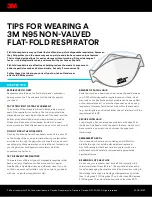
1.
TECHNICAL
DESCRIPTION
The
respirator
is
made
of
a
half
facepiece
moulded
in
rubber,
CE
approved
to
EN
140:98,
which
fits
to
any
face
shape
without
unpleasant
pressures
and
provided
with:
Exhalation
valve
Head
harness,
four
arms,
with
rest
for
the
nape
of
the
neck
made
of
moulded
polyethylene
and
elastic
strap
with
four
quick
adjusting
buckles
Standard
threaded
connector
EN
148
‐
1
PVC
protection
cap
for
the
exhalation
valve
seat
Hood,
front
made
of
flower
leather
and
back
of
strong
waterproof
fabric,
for
the
protection
of
the
head
from
splinters
and
dusts
that
may
be
encountered
during
normal
working
operations
Polycarbonate
frame,
which
holds
a
replaceable
plain
glass
visor.
AN
inner
polycarbonate
anti
‐
mist
visor
prevents
any
possible
splinter
from
hitting
the
face
of
the
user
in
case
of
accidental
breakage
of
the
main
visor
The
polycarbonate
visor
is
certified
to
EN
166
point
7.2.2
(high
speed
impact
=
120
m/sec).
2.
LIMITS
OF
APPLICATION
RC4
respirator,
as
all
particle
filter
respirators,
must
not
be
used
in
tanks,
tubs
and
shafts
and
in
general
in
confined
spaces
where
the
Oxygen
concentration
is
lower
than
17%
by
volume
or
polluted
by
toxic
and
dangerous
gases.
In
these
cases
it
is
advisable
to
use
air
line
fed
respirators
ACS
951
or
ACS/ACM
952
or
suitable
combined
or
gas
filter
respirators.
The
hood,
made
of
leather
and
fabric,
is
not
designed
to
protect
from
chemicals.
It
shall
be
used
only
to
protect
from
the
projection
of
abrasive
particles
in
sandblasting,
scraping
and
grinding
operation
or
from
dusts
produced
in
welding
in
combination
with
our
filters
type
100
LD
P3
R.
See
the
instructions
for
use
of
the
filters
for
more
information.
The
respirator
is
not
suitable
for
bearded
people,
since
the
beard
impedes
the
tightness
of
the
mask
on
the
face.
It
is
advisable
to
avoid
frequent
wandering
about
whilst
wearing
the
masks,
because
the
special
shape
of
the
hood
and
harness
reduce
the
field
of
vision.
3.
DIRECTIONS
FOR
USE
3.1
Donning
Turn
inside
out
the
hood
to
have
halfmask
and
harnesses
free.
Don
the
carrying
strap.
Make
the
mask
adhere
to
the
face
by
passing
the
plastic
bow
behind
the
head.
Adjust
the
carrying
strap
to
obtain
the
right
pressure.
If
necessary,
adjust
the
tension
of
the
upper
elastics
by
making
them
slide
though
the
arches.
Put
the
hood
back
on
the
head.
Pull
the
hood
straps
situated
on
the
shoulders.
Screw
the
filter
on
before
entering
in
polluted
area.
If
required
fit
the
protection
cup
of
the
exhalation
valve
in
its
correct
site.
4.
CLEANING
AND
STORAGE
The
rubber
used
is
age
resistant
and
therefore
no
special
care
is
required
for
storage,
it
is
advisable,
though,
to
keep
respirators
in
their
original
packing
and
store
them
away
from
chemical
vapors
and
heat
sources.
Store
respirators
at
the
humidity
and
temperature
conditions
stated
in
the
pictograms
stamped
on
the
packaging
and
described
at
the
end
of
this
information
notice.
After
use
masks
must
be
cleaned
with
a
soft
cloth
to
remove
sweat
and
condensate.
If
they
are
really
dirty,
they
can
be
washed
with
a
mild
detergent
in
lukewarm
water.
The
hood
can
be
brushed.
Special
care
shall
be
put
in
the
cleaning
of
exhale
valves
which
are
particularly
likely
to
wear
out
and
shall
be
replaced
whenever
they
show
signs
of
deterioration.
5.
MAINTENANCE
5.1
Glass
and
/
or
safety
polycarbonate
visor
replacement
Unscrew
the
hand
wheel
on
the
frame
holding
the
visor.
Take
out
the
cams
and
replace
the
glass
and/or
the
polycarbonate
safety
visor.
Put
the
cams
back
in
position
to
hold
the
glass
and
polycarbonate
visor
in
their
site,
and
then
screw
the
wheeled
‐
screw.
WARNING
:
The
glass
visor
must
always
be
placed
outside.
The
polycarbonate
safety
visor
must
always
be
placed
inside
the
hood
with
the
anti
‐
mist
part
faced
to
the
user.
5.2
Replacement
and
cleaning
of
exhale
valve
Pull
the
protective
cap
out.
Unscrew
the
valve
cover.
Take
the
valve
seat
out.
Clean
or
replace
the
valve
membrane.

















